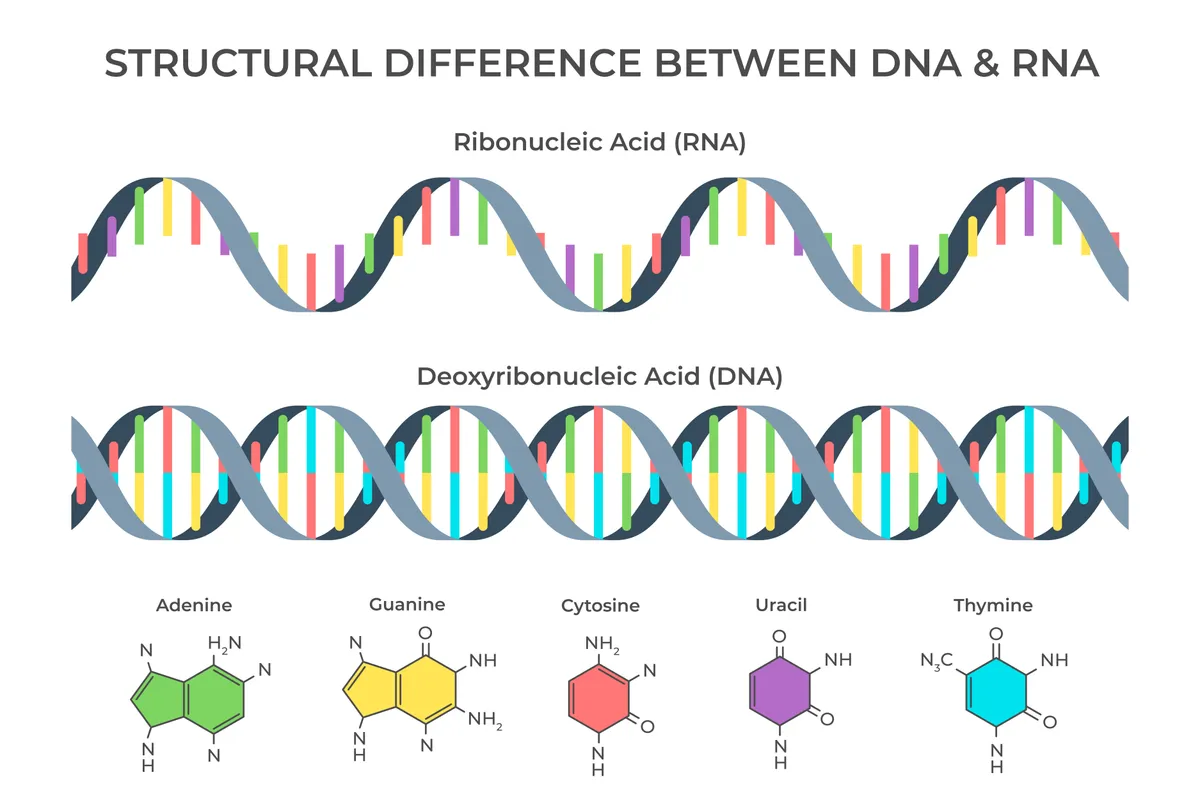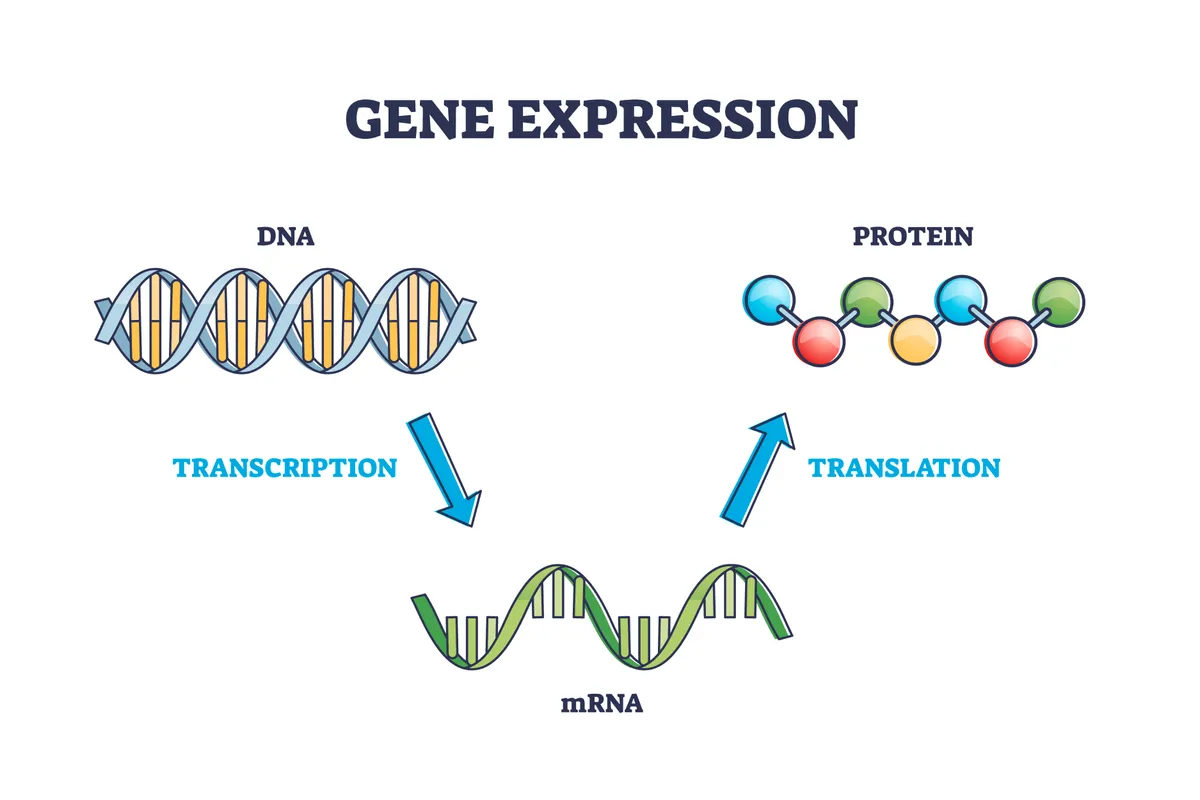What is RNA made of?
Like its more famous chemical cousin, deoxyribonucleic acid (DNA), ribonucleic acid (RNA) is a nucleic acid - a molecule assembled from a chain of building blocks called nucleotides. In terms of composition, each nucleotide comes with one chemical letter or 'base':
- Adenine (A)
- Cytosine (C)
- Guanine (G)
- Thymine (T)
- Uracil (U)
Although both forms of nucleic acid use a four-letter alphabet that includes A, C and G, DNA uses T, whereas RNA uses U.
However, it's a relatively trivial difference, as T and U are read as equivalent bases, like capital and lowercase versions of the same letter.
RNA is often a standalone chain. However, in complex cells, DNA strands are arranged as chromosomes: they're wrapped around large histone proteins, like thread wound around a spool. That arrangement is possible because, with millions of letters, DNA is generally several orders of magnitude longer than RNA.
The shortest RNAs are microRNA and small-interfering RNA, at just 20-30 nucleotides in size, and the longest RNA in humans is a copy of the titin gene, at 109,224 letters long.
What does RNA do?
RNA carries biological information. DNA's function is to store information in the genome - the book of life, or instruction manual for creating an organism.
RNA, on the other hand, plays various roles that influence how genes (DNA's instructions) are read, which determines characteristics like observable features and physiology.
The human genome contains over 6 billion letters, but only around 1 per cent of DNA encodes genes for making proteins - the molecules that perform the majority of tasks, such as working as the enzymes (biological catalysts) that trigger the chemical reactions that sustain life.
The remaining 99 per cent is non-coding: most is harmless 'junk DNA' but some are genes whose end product is RNA itself.
Read more about DNA:
- Everything you need to know about DNA (almost)
- Quantum weirdness could be the driving force behind DNA mutations
- The DNA Detective: How to solve family mysteries with ancestry testing
What's the difference between RNA and DNA?
RNA is 'ribonucleic acid' and DNA is 'deoxyribonucleic acid'.
The two forms of nucleic acid have similar backbones, which consist of two alternating chemical groups: phosphate and a sugar, ribose. The sugars in DNA's backbone are missing a hydroxyl group (hydrogen plus oxygen), turning ribose into deoxyribose.
This tiny difference has a huge impact on chemistry: with its more reactive ribose sugar, RNA is more likely to react with other molecules - and even itself.
The two nucleic acids also differ in structure. While RNA is typically a single-stranded molecule, DNA forms the iconic double helix - dual strands that spiral around one another like a twisted ladder.
The ladder's rungs represent hydrogen bonds - electrostatic attractions that link complementary letters on opposite strands into pairs: A with T, C with G. That base pairing occurs all the way along DNA, holding its strands together, like teeth on two halves of a zipper.
Unlike DNA, RNA doesn't usually exist as one long double-stranded molecule, but as a solitary strand. And yet, complementary letters from separate sections of an RNA strand can pair together ('AAAA' matching 'UUUU', for example), which forms double-stranded regions called stems.
Such pairing doesn't occur at every point in the molecule, however, and many sections remain single-stranded. Overall, an RNA will often include structures known as 'hairpin loops'. RNA can sometimes pair with DNA, but the size difference means full DNA-RNA hybrids don't occur.

Why is RNA relatively unstable?
DNA is arranged in chromosomes, which helps protect its structural integrity. The double helix is also more stable than RNA thanks to the bonds between base pairs along its entire length. By contrast, RNA molecules have short (if any) double-stranded stems holding them together, which makes them more likely to fall apart. Because RNA's single-stranded loops aren't engaged in base pairing, they're also exposed and vulnerable to enzymes that break down nucleic acids.
Stability explains why RNA and DNA tend to have distinct functions, even though they're both capable of carrying genes. Being more stable means DNA is a better molecule for permanent storage of genetic instructions, which must be inherited mostly unchanged from one generation to the next.
But RNA's instability has its advantages, as an RNA copy of a gene lets instructions have a temporary effect: for example, if DNA directly instructed pancreas cells to make insulin protein, the body would keep converting glucose to glycogen or fat - preventing it from being used as fuel.
Copying DNA to RNA is therefore useful for making proteins.
How is RNA used to make proteins?
RNA is integral to gene expression, the process of synthesising a protein by following instructions encoded in DNA. The first step involves RNA polymerase, an enzyme that unwinds and unzips the double helix to access a protein-coding gene. The gene's DNA sequence is used as the template for transcribing an RNA copy of that gene, which the polymerase assembles from a chain of nucleotides.
The transcription step resembles DNA replication, the process that duplicates a cell's genome before it divides. In organisms like bacteria, that cell division involves binary fission, whereas eukaryotes - organisms where DNA is contained within a cell nucleus - will duplicate their DNA during division by mitosis.
In the cells of a eukaryote, the newly-transcribed copy of a gene is exported to the cytoplasm as 'precursor messenger RNA' (pre-mRNA). Protein-coding genes are rarely a continuous DNA sequence, but are commonly split into segments whose RNA is spliced together in alternative combinations - like a regular and director's cut of a film - so one gene can make numerous different proteins.
The splicing process produces an mRNA molecule whose nucleotide alphabet (A-C-G-U) must then be translated into amino acids, the building blocks and language of proteins.
The translation step involves the ribosome, a protein-making factory that uses another type of RNA - a clover leaf-shaped adapter called transfer RNA (tRNA), which matches a three-letter word (codon) in mRNA and also carries one specific amino acid (such as 'AUG' for the tRNA carrying methionine).
Like paper passing through a printer, an mRNA strand is pulled through a ribosome as one tRNA at a time binds to its matching word and its amino acid is added to a growing chain. That chain is folded into a 3D structure in the final step of protein synthesis.

What is the RNA world?
The RNA world is a theory related to the origin of life. More precisely, it's a hypothesis for how genes replicated and adapted on prebiotic Earth; evolution before life emerged. That requires a genetic system.
Today, cells use a system in which instructions in DNA make proteins while proteins replicate DNA, which creates a chicken-or-egg paradox. Which came first?
One solution is neither.
According to the RNA world hypothesis, early systems revolved around RNA. The strongest evidence to support that idea comes from the cell's protein-making factory, the ribosome: instead of being built from protein, the core component of a ribosome is actually an enzyme-like molecule made of ribosomal RNA (rRNA): a ribozyme.
Scientists have since discovered other ribozymes and designed self-replicating RNAs as proof-of-concept for what might have existed on an RNA world.
Although the hypothesis may not be correct, it does explain the molecule's versatility: RNA has the ability to not only carry genes but, like proteins and unlike DNA, the chemistry of its single strand enables RNA to fold into an enzyme-like structure that can modify other molecules.
10 milestones in RNA research
- 1868: Friedrich Miescher isolates the material 'nuclein' from the nucleus
- 1953: James Watson and Francis Crick discover DNA's double-helix structure
- 1961: François Jacob and Jacques Monod suggest that DNA is transcribed to RNA
- 1962: Alexander Rich proposes a hypothesis, later popularised as the 'RNA World'
- 1965: Robert Holley reveals the stem-loop structure of a transfer RNA adapter
- 1966: Scientists crack the genetic code for translating RNA into protein
- 1977: Phillip Sharp and Richard Roberts find split genes and RNA splicing
- 1982: Thomas Cech discovers standalone ribozymes that serve as catalysts
- 2002: Gerald Joyce creates self-replicating RNA molecules that can evolve
- 2012: Emmanuelle Charpentier and Jennifer Doudna invent CRISPR guide RNA
Read more about the body:
